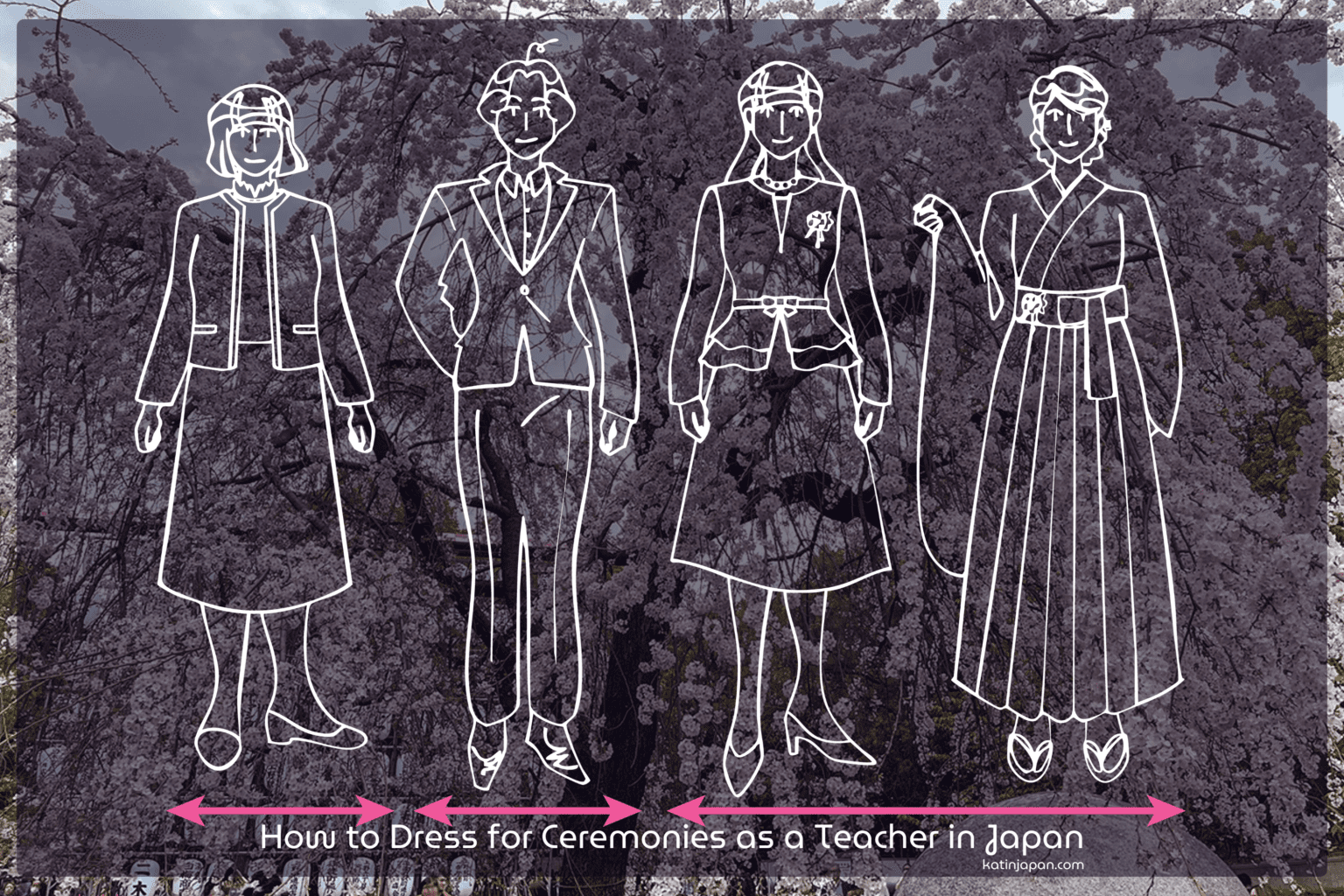One of the most confusing things about working as an ALT in Japan is the dress code.
Guidelines vary from school to school and company to company. And formal wear is an even more complicated affair.
However, you can follow these key guidelines to look sharp for your students’ opening and graduation ceremonies.
Check out my top tips for how to dress for ceremonies in Japan as an ALT below!
My Credentials
There are differing levels of formality in situations across Japan.
However, if you come from a different culture, especially one as informal as California, these can be hard to navigate.
Hell, Californians wear board shorts and polos to work. Programmers even get away with wearing pajamas where I’m from!
So my knowledge of appropriate business wear went as far as my zillenial experience of wearing business casual in my teens.
Gallery: California art-kid credentials. Business casual is California formal.



I had to learn the ropes of formal wear while practically on the job.
Another thing worth mentioning is much of these guidelines will be gendered. Japan is still very binary, especially in the workforce. So you can’t go wrong with a suit no matter your gender.
And of course, use what works for you and don’t worry. As a foreign worker, you’ll usually get a little slack for not knowing the in’s and out’s of Japanese formal wear, especially in the beginning.
The levels of Formal Wear in Japan for Teachers

1. Formal (Ceremonial) 正礼装 (seireisō)
Suitable for graduation ceremonies and official occasions. Also called ‘black formal’ (ブラックフォーマル).
Teachers in charge of the graduating class may wear hakama regardless of gender. Men may wear morning coats.
2. Semi-Formal (Professional) 準礼装 (junreisō)
Less formal than ceremonial, but still appropriate for opening and closing ceremonies.
For new teachers, a plain black suit will do.
3. Semi-Formal (Business Casual) 略礼装 (ryakureisō)
A clean appearance, but not suitable for graduations or other ceremonies.
This is common for small assemblies, parent-teacher conferences, and other day-to-day events.
Be advised that these are guidelines for school events. Weddings and funerals have their own special rules.
What’s the Deal with Indoor Shoes?
Something you may have noticed is that teachers have several pairs of shoes. They’ll pull them out from a secret compartment and bam! Full formality achieved.
As ALT’s we usually get by with just a pair of sneakers or loafers. However, it’s a good idea to have a pair of formal indoor shoes as well – even if you just keep them at home.
These shouldn’t be a pair you wear outside. If you absolutely must use an outdoor pair, be sure to wash them thoroughly before use inside.
What to Wear to Opening and Closing Ceremonies
Opening ceremonies, aka 入学式 (nyūgakushiki) or 始業式 (shigyōshiki) are essentially assemblies conducted before the start of a new term at Japanese schools.
Closing ceremonies, 終業式 (shūgyōshiki) or 終了式 (shūryōshiki) are the same, but for the end of the term.
Both are formal, but less so than graduation ceremonies.

For opening and closing ceremonies, simple is best.
You can wear a black suit. Other acceptable suit colors are navy and grey.
If it’s your first time at an opening ceremony, wearing a white dress-shirt or blouse is a safe bet.
You don’t need a corsage or fancy jewelry. Just a clean appearance is fine.
If it’s cold in your area, you can wear heat tech or other long underwear under your nice clothes.
Tip: Keep a suit jacket or blazer in your car or locker at school just in case of unexpected events.
Women
- If you wear a skirt or dress, definitely wear stockings or tights.
- Feel free to wear some light accessories like corsages or pearls if you have them.
- Black pumps (~1 inch) are standard. Black dress shoes are fine as well.
- Navy, black, and white, and some light pastels are acceptable blouse colors.
Men
- A white dress shirt is standard.
- Light tie colors like blue or silver are good.
- You don’t necessarily need to be clean-shaven, but your appearance should be neatly arranged. Refer to your company guidelines.
How to Dress for Graduation Ceremonies

While you can shell out the extra cash for a full ceremonial dress set, this cost isn’t practical for most ALTs.
As long as you are presentable in black suit attire, you shouldn’t have any issues.
However, if you’re looking for a nicer suit, you can find nice second-hand pieces and blouses at stores like Second Street.
Many clothing shops will also have suits, blouses, and corsages out from January to March in anticipation of occasions like this.
To appear a more put-together, I recommend wearing a corsage or brooch. If you have pearls, you can wear those too.
If you really want to buy a formal suit, there are suit retailers in malls and shopping plazas like Aoki and Aoyama.
Online retailers like Suit-Select and Rakuten are also popular.
Women
- A dark black suit is fine. Black formal suits are the norm amongst teachers.
- Black stockings or tights are a must with a skirt.
- Corsages or pearls are recommended if you have them. You can buy cheap corsages (under 2000¥) at shops like Honeys or online retailers.
- Black pumps (~1 inch) are standard. Black dress shoes are fine as well.
Men
- A typical black suit is okay. Navy or charcoal grey may be acceptable.
- A white pocket square and white or light grey tie are recommended.
- Black dress shoes are standard. Try to avoid very shiny material.
What’s the Difference between Formal and Ceremonial Wear?
Businessmen and women have a large selection of clothing available to them for everyday use.
Just because you can wear suits during your everyday work doesn’t mean they’re appropriate for special occasions, though.
Ceremonial wear, also called ‘black formal’, is characterized by its deep black color and matte finish.
Regular suits by comparison are more like charcoal black. Some sites recommend velvet, as it is a deep, luxurious black.
Normal business suits make appearances in everyday life, from opening and closing ceremonies, to daily work.
While you may be able to wear hakama or kimono for your personal events like Coming of Age Ceremonies or festivals, they aren’t something you should wear to school unless specifically asked.

What do Japanese Teachers Wear?
Opening and Closing Ceremonies
In my experience, teachers wear suits to the opening and closing ceremonies. Women may wear pantsuits or skirt suits.
Generally the color to wear is black, but not ceremonial black. Some teachers will wear tweed, grey, and beige. You can observe what they wear and tailor your own approach.
Opening and closing ceremonies are less uptight than graduation ceremonies.
Graduation Ceremonies

For Japanese teachers, the level of formal wear will be affected by their role in the school.
Ninth Grade is the last year of required education in Japan, so these ceremonies place heavy importance on the experience of the graduating class.
Homeroom teachers (担任 tan’nin) of the graduating class wear hakama or ceremonial black suits.
Male homeroom teachers can opt to wear a morning coat or tailcoat.
Teachers who aren’t in charge of the graduating class wear black formal (women) or suits (men).
Students only wear their school uniforms. There are bouquets, speeches, and choruses on the day-of.
The graduating class may be adorned with special corsages or do their hair specially. The parents may even bring their students’ phones for after the ceremony!
Final Thoughts
Don’t stress about what to wear to ceremonies. As an ALT, you aren’t expected to understand the intricacies of formal wear right off the bat.
However, looking sharp and showing respect for these ceremonies is the most important thing.
It shows that you care about the school and students you’re working with. And it has the added bonus of making you feel part of the group.
Lastly, if you want to know What to Wear as an ALT in the Summer, you can check out my post on it, or learn the top 7 Things to Bring to your First day as an English Teacher in Japan.




